Back to Don's Maps
Shanidar Cave in Northern Iraq
Photographs and text are from Dr Ralph Solecki's book, Shanidar 1971 (unless otherwise attributed) and are used by kind permission of Dr Solecki.
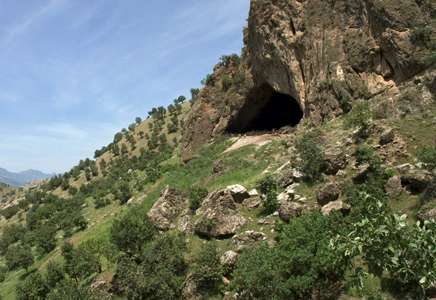
Shanidar Cave
View of the exterior of Shanidar Cave, taken during the summer of 2005. Note for scale the two crouching men in front of the cave. At the time this photo was taken, the interior of the cave was being used as a pen by a local shepherd.
Photo: Wikimedia, originally uploaded by JosephV at en.wikipedia, GFDL licence, released under GNU.
The Clan Cave in the EC series is located on the Crimean Peninsula, but the original was excavated by Drs Ralph and Rose Solecki hundreds of kilometres away in Iraq.
Click on the photos to see an enlarged version
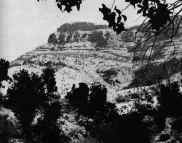
Distant shot of cave entrance. The cave is to the right and below the centre of the photograph.
(
 )
)Photo: Dr Ralph Solecki
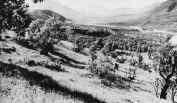
Shanidar Valley
Photo: Dr Ralph Solecki
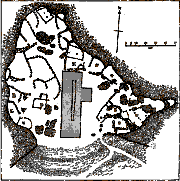
Shanidar Cave Plan
The excavation in the cave is marked in grey. The broken line within it is the first test trench done in 1951.
Photo: Dr Ralph Solecki
From: Shanidar Cave, by Dr Ralph Solecki
The Zagros Mountains resemble the highlands of Scotland; their foothills look like the hills of the U. S. Southwest. Shanidar Cave is in a mountain called Baradost, overlooking Shanidar Valley. From the cave mouth one can see the Greater Zab River, a tributary of the Tigris. The cave, now some 2,500 feet above sea level, was dissolved out of the mountain's limestone rock, originally laid down by an ancient sea. It has a flat earthen floor, about 11,700 square feet in area, and a high ceiling (45 feet at the highest point) blackened with a centuries-old deposit of soot. The Kurdish goatherds and their families, who live in the cave all winter from November to April, have built individual brush huts inside it, each with a small fireplace, and corrals for goats, chickens, cows and horses [see drawing on page 451. The Kurds are a proud, self sufficient, but backward people. They make fire with flint and steel and grind wheat by hand with circular stones. The women cut hay in the mountain meadows with short iron sickles and toil barefooted up a mountain trail with goatskins to fetch water from the springs. Compared with modern Baghdad, only 250 miles away, the present dwellers in Shanidar Cave could just as well be living in the days of the Assyrian herdsmen 2,500 years ago.
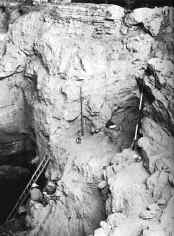
Excavation in the Shanidar Cave. Conditions are obviously difficult and dangerous, and there is a considerable depth of sediments.
Photo: Dr Ralph Solecki
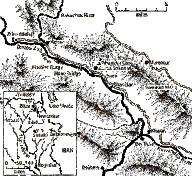
Map of the Shanidar location. The original cave is located in Iraq, close to Turkey and Iran.
Photo: Dr Ralph Solecki
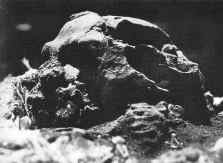
Skull of Shanidar I, the inspiration for Creb in the Jean Auel series.
Skull as it looked when first found.
Photo: Dr Ralph Solecki